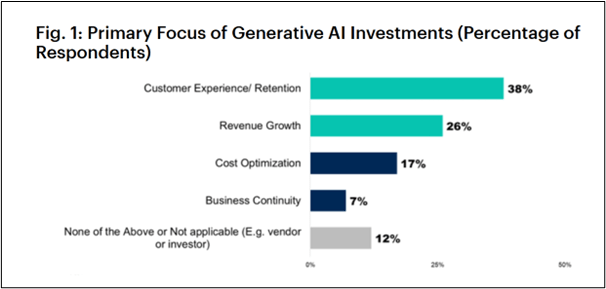
Blog
AI in Customer Experience and Its Impact on Businesses

Keeping today’s customers happy and satisfied is becoming complex as preferences evolve and competition grows. As Gen Z and Millennials become the major spenders in the economy, businesses that can effectively meet their expectations for digital-first and highly personalized experiences are more likely to outpace competitors in revenue growth.
With advancements in personalization, predictions, customer support and employee workflow, it’s no surprise businesses are turning to AI to better meet these higher expectations. In fact, 92% of decision-makers say generative AI helps them deliver better customer service. In this article, we’ll explore how businesses are leveraging AI to improve customer experience (CX) and how you can do the same with methods like these:
- Personalization – AI analyzing past purchases and browsing behavior to tailor recommendations.
- Predictive Analysis – AI analyzing sentiment and trends to forecast customer needs.
- Customer Support Availability – AI responding to user queries, enabling instantaneous self-service at any time of day.
- CRM Automation – AI processing unstructured data to identify churn risks and upsell opportunities.
- Document Management and Reporting – AI workflow assistance with tasks like file management, versioning and automation.
How AI Is Improving Customer Experience for Businesses with Real-World Examples
Since the rise of digital transformation, business leaders have continued to experiment with AI potential across all sectors. Knowing that CX is the core, business leaders have prioritized using AI to improve customer experience amidst other business KPIs, according to Gartner findings.

Source: Gartner
With AI’s ability to interpret customer data and predict expectations, these businesses have been able to close the gap between expectation and delivery. This in turn makes it easier to offer personalized service, understand customers better, nurture customers across different touchpoints and make data-driven decisions. We’ll explore each of these transformations below with real-life examples.
1. Increased Personalized Recommendations
With customers expecting businesses to offer quick and personalized responses, the reactive (traditional) customer service approach isn’t keeping up with demand. Then AI came to the rescue, allowing analysis of individual customer data in real time to provide businesses with recommendations.
This way, companies can offer proactive solutions, personalized service and products that suit customers’ current needs. While it’s easy to consider the ecommerce industry as the sector experiencing this shift, other industries, such as finance, legal, construction and insurance, are not left behind.
Many AI tools, such as ChatGPT, Amazon and Gemini, use machine learning to study users and provide unique solutions for different situations. However, their application may differ depending on your business goal in meeting client expectations.
For example, ecommerce store Sephora used AI to provide a personalized shopping experience for customers by allowing them to try on makeup virtually. This enhances decision-making, improves brand trust and boosts online shopping experience for users. Likewise, Workday, a human capital and financial management company, leveraged the power of AI to deliver region-specific inference requests to customers based in Europe, the Middle East and Asia.
The examples above differ, but they represent the dynamic applications of AI across different industries in alignment with their CX goals.
2. Improved Predictive/Sentiment Analysis
Understanding customers' behavior, emotions, needs and expectations is critical for an excellent customer experience. At the same time, it’s a complex pursuit that AI technology can simplify. With customers interacting across multiple platforms, AI provides efficient ways to analyze large datasets from conversations, reviews and mentions. Over time, businesses can leverage real-time data to refine marketing strategies, enhance product features and align with customer expectations.
Beyond gathering customer insights, AI-powered sentiment analysis provides a competitive advantage by analyzing competitors' audiences for valuable trends. This technology can foster a positive workplace culture by assessing employee emotions and engagement—factors that ultimately influence CX.
Seeking a real-life example of how sentiment analysis plays out? The Fifth Third Bank is a great case study here. With a strong intent to understand its customer experience, the bank leveraged an AI-powered emotion-analysis tool to score customer satisfaction from every call and conversation and identify trends. In the long run, the bank made data-based decisions, which led to improved employee productivity, cost savings and brand website positioning improvement.
3. Enhanced Customer Support Availability
Regardless of your business category, whether service- or product-based, a fast response rate is critical to customers. Customers even say they prefer AI-powered interactions rather than waiting for human response. These trends show that customers want quick and reliable solutions at all times. As a result, CX leaders in organizations are investing in chatbots and virtual assistants to provide consistent support availability across all channels. This positively impacts customer satisfaction with quick support and improved employee efficiency at being strategic.
While chatbot interactions are common on websites and ecommerce platforms, there are more applications. For example, JPMorgan, an American financial service, has a ChatGPT-like bot that assists employees with research-based tasks to enhance decision-making. Another use case is with Helvetia, an insurance group. The group launched a chatbot, Clara, to provide an easy way for customers to ask questions and describe issues via the website.
4. Advanced Customer Relationship Management
What differentiates a traditional CRM from an AI-powered one is the possibility of automation, which boosts employees' efficiency and customer experience. For instance, with the predictive nature of AI, marketing leaders can analyze customers' information and tailor marketing content to their preferences, demographics and behavior.
This level of personalization saves time and effort while driving engagement and conversion. Additionally, having an AI-integrated CRM that can analyze unstructured data like high churn rates or active clients guides employees in making strategic decisions. This spurs a proactive customer service approach, allowing support to provide targeted recommendations.
Featurespace, a fraud and financial management company, launched TallierLTM, which is designed to support the finance industry with fraud detection. By integrating TallierLTM API into finance CRM, financial experts can quickly analyze transaction history and other spending trends. According to Featurespace innovation officer Dr. David Sutton, this invention has improved up to 71% in fraud value detection since its release.
5. Improved Employee Efficiency with Document Management and Reporting
Everyone has a role to play in customer experience. This is because regardless of an employee's duty in an organization, what we do today can impact customers well into the future. In fact, something as small as smudges could affect customers' perception and experience, says Brad Cleveland, a CX consultant. Therefore, achieving an excellent customer experience must touch every aspect of a business, starting with its workers.
Thanks to AI, employees can now work more efficiently with AI-integrated workflows. A recent survey shows that 47% of employees experience poor document management in their organization, which indirectly impacts CX. For example, AI-powered documentation can support employees with a faster onboarding process, improving customer experience.
Today, many documentation and reporting tools are integrating AI into their workflow for improved performance through automation. CryptoTaxAudit, a finance company, used Progress ShareFile integrations to streamline all client documentation leading to improved data accuracy and time management, and cost savings of more than $30,000 yearly.
"CryptoTaxAudit saw cost savings of more than $30,000 yearly after implementing ShareFile to streamline client documentation."
While documentation and reporting are key to tracking business processes, it’s also important to identify which aspects of the process AI can enhance to improve employee efficiency.
The Smart Approach to Implementing AI in Customer Experience
Having seen AI’s powerful transformation in businesses, how do you integrate it into your organization’s strategy without sacrificing customers’ expectations?
Steve Jobs, the late co-founder of Apple, said it all: “You've got to start with the customer experience and work backwards to the technology.” However, many businesses have ignored this principle by eliminating human support and replacing it with bots, thinking these bots will suffice.
Following Steve Jobs' advice, it’s critical to start with your customer experience strategy. Below are three fundamental steps to take for a more effective AI integration into your customer experience.
- Review your customer experience strategy. Regardless of your organization's CX strategy framework, start with your customer’s profile. Understand each component of your customer’s profile, such as needs, channel of interaction, pain points, emerging needs, demographics, etc.
- Envision how AI can help with each component of your customer experience strategy. Considering that AI technology is broad, set up a small team around each component to brainstorm on how AI can be of great advantage.
- Understand the overall impact of AI on all three levels of your business success, which include efficiency, customer satisfaction and strategic value. Sometimes, the implemented AI technology may impact all these levels or just one. For example, CryptoTaxAudit's use of ShareFile focused on efficiency, which later impacted its client satisfaction through simplified client-facing workflows.
To avoid AI implementation that doesn’t move the needle, start small with a few key areas that will impact your team and CX, and iterate. Above all, AI should augment and not replace human efforts.
Continue Learning How to Elevate Your Client Experience
Borrowing the words of Greek philosopher Heraclitus, “Change is the only constant in life.” Likewise, in this era of technological advancement with AI, what used to be the best tools and strategies today may become obsolete tomorrow.
Client expectations evolve, and so must the experiences you create. Nevertheless, automation and AI will continue to play a significant role. By aligning your business value with clients’ expectations, you can strategically integrate AI into your workflow for a better experience.
Irrespective of your industry, invest in continuous learning and the right technologies to stay ahead and adapt. Long-term success lies in an ongoing commitment to learning and refining your approach to deliver even better customer experiences.
Ready to take the first step? Learn how to elevate your client experience.
Related Resources
